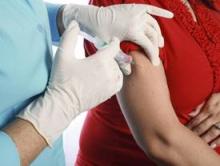The monovalent inactivated ASO3-adjuvanted influenza A(H1N1)pdm09 vaccine used in Denmark during the 2009 flu pandemic showed no association with adverse fetal outcomes, according to a report in the July 11 issue of JAMA.
This vaccine, which contained the same H1N1 viral antigens to those in the nonadjuvanted vaccine used in the United States, was not related to major birth defects, preterm birth, or fetal growth restriction in a nationwide cohort study of 53,432 live-born singleton infants delivered in Denmark during the 2009-2010 influenza A(H1N1) pandemic, said Dr. Björn Pasternak of the department of epidemiology research at Statens Serum Institut, Copenhagen, and his associates.
"Together with our [previous] findings of no significantly increased risk of spontaneous abortion and stillbirth associated with vaccination, these data provide reassurance of the safety of the ASO3-adjuvanted A(H1N1)pdm09 vaccine in pregnancy.
"Our data might be generalizable to nonadjuvanted A(H1N1)pdm09 vaccines because they contain identical viral antigens, although the antigen doses and manufacturing processes may differ. However, results from this study do not provide evidence of safety for vaccines with other adjuvants," the researchers noted.
They added that "apart from providing information on influenza A(H1N1)pdm09 vaccine safety in pregnancy in retrospect, studies such as ours may have implications for future influenza seasons and pandemics; in some circumstances, the use of adjuvanted vaccines will likely be critical to achieve sufficient host immune response."
Dr. Pasternak and his colleagues identified 6,989 infants (13% of the total born that year) who had been exposed to the vaccine during pregnancy. This included 345 infants who had been exposed during the first trimester and 6,644 who had been exposed in the second or third trimesters.
They adjusted the data to account for numerous potential confounders of an association between exposure and fetal outcome, such as maternal age, parity, smoking status, body mass index, comorbidities, drug use, and reproductive history.
In an unmatched analysis, infants exposed to the vaccine during the second or third trimesters did not have an increased prevalence of any adverse outcome, compared with unexposed infants. Rates of preterm birth were 4.6% with second- or third-trimester exposure and 4.6% with no exposure, and rates of small size for gestational age were 9.7% and 9.9%, respectively.
Because this analysis was based on data from well over 6,000 exposed infants, it provides "robust evidence of [vaccine] safety with high precision," the investigators said (JAMA 2012;308:165-74).
However, the number of infants exposed during the first trimester was much smaller, and because first-trimester vaccination was largely restricted to high-risk pregnancies, these infants were already at elevated risk for adverse outcomes. So a different method of analysis was needed to accurately compare this group with unexposed infants.
Therefore, 330 of the infants exposed during the first trimester were propensity-matched with 330 unexposed infants. No unexpected cluster of birth defects occurred, nor was there any significant difference in rates of low birth weight (4.5% and 5.5%, respectively) or preterm birth (9.4% vs. 7.3%). But given the small numbers, these results "should be viewed as preliminary and in need of confirmation," Dr. Pasternak and his associates said.
This study was funded by the Danish Medical Research Council. No financial conflicts of interest were reported among the study authors.


